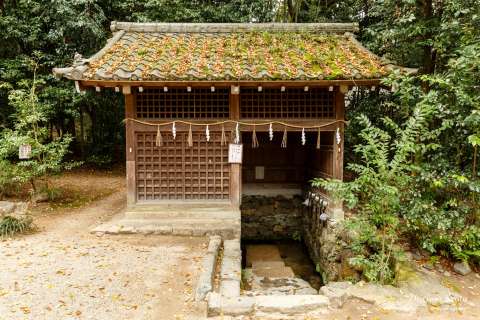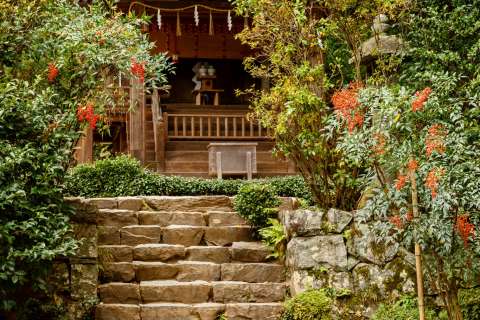Ujigami Jinja|宇治上神社
Overview

Despite the fact that the Ujigami Shrine is often overlooked by travelers to Uji who flock in hordes to Byōdō-in Temple and shopping streets filled with green tea treats, Ujigami Shrine is a UNESCO World Heritage Site believed to possibly be the oldest extant Shinto shrine in the country. Located just a few minutes’ walk away from Byōdō-in over the Uji River and behind the newer Uji Shrine, Ujigami Shrine is an example of the most classic of Shinto architecture tucked into a small, nature-filled alcove against the rolling hills of southern Kyoto. Though the grounds aren’t large, they provide an interesting contrast to the shrine architecture visitors may have already grown accustomed to, with the main hall contained in a large wooden “cage” of sorts. If you’re in the area it’s worth stopping by for the oldest remaining shrine, the lush greenery and water, and the many cute rabbit-shaped charms!
Ujigami Shrine is a UNESCO World Heritage Site believed to possibly be the oldest extant Shinto shrine in the country.
Features
Rabbit, Rabbit
Around Uji you might notice an adorable presence… Everywhere you look there’s rabbits! On the bags, set in stone amidst gardens, on a local shrine charm, and as silhouettes in fabric, there are rabbits every which where! Various legends explain the city’s obsession, from a divine rabbit that guided Uji’s local god when he once became lost to old kanji characters for the city's name that had the same reading and meant “the road of rabbits”, but whatever the real reason, the rabbits are here to stay. At Ujigami Shrine there are adorable little figurines available for purchase, but hidden within is an omikuji fortune paper! Why not let a rabbit predict your future?
Kiriharasui

The grounds of Ujigami Shrine contain what might confuse visitors from the outside- a small hut with a few stairs going down into… water? This is a freshwater spring once used for purification rituals at the shrine, and those interested can do the same today if you choose to enter the structure. Standing on a broad stone just above water level, you’re free to perform ablutions with the ladle provided.
Prayer Hall

Those who have spent some time seeing UNESCO sites in Kyoto might find something familiar about this Prayer Hall… the tatesuna in front! Two sand structures meant to abstractly represent mountains are carefully set in front of the hall, which is itself a rare representation of its kind. Prayer Halls are usually open on all sides to serve as stages, but the hall at Ujigami Shrine has walls and more closely resembles a residence.
Main Hall

The feature that sets Ujigami Shrine apart from others is its Main Hall. Actually made of three altars with the largest in the middle, all of them are enclosed in a wooden “cage” of sorts that partially hides them from view and keeps them apart. This is considered the oldest example of nagare-zukuri style in the country, and is the part of the shrine that was scientifically dated to approximately 1060, making it the shrine with the oldest provable structure remaining that hasn’t been destroyed by fire, earthquake, or man. The wood used in the construction of Ujigami Shrine’s main hall connects the people of today with people who lived and worshipped a thousand years in the past.
History
Thanks to dendrochronology (the study of tree rings to deduce age), it has been proven that Ujigami Shrine may be the oldest standing shrine building in the entire country, dated to construction in the year 1060.
Ujigami Shrine was founded to commemorate Emperor Ōjin, the 15th Emperor of Japan, as well as his two sons, Uji no Wakiiratsuko and Uji no Ōsazaki (Emperor Nintoku), with the main deity of worship being Prince Uji no Wakiiratsuko. In order to resolve a quarrel over the issue of imperial succession, he committed suicide to allow his brother to take the throne as Emperor Nintoku. Ujigami Shrine was later raised in his honor, and also served as a guardian shrine for the large Byōdō-in Temple across the river.
Though the main hall dates to the founding of the shrine, other structures were added or replaced at later dates. The Prayer Hall was constructed in the Kamakura period (1185-1333), as was the Kasuga sub-shrine on the property. Though Ujigami Shrine and Uji Shrine, located just a few meters down the road, were once considered one shrine, they were separated in the Meiji period.
Despite various civil wars that ravaged the Kyoto area (some of which destroyed nearby Byōdō-in and Mimuroto-ji temples) and the risk of natural disaster such as fire, lightning, or storm, Ujigami Shrine has remained largely intact for a thousand years.
Access
Address
〒611-0021 Kyoto Prefecture, Uji, 宇治山田59
| TEL | 0774-21-4634 |
Admission
- General Admission: Free
Hours
- General Admission: 09:00 – 16:00
- Closed: No closing days
Transportation
Gallery
-




 +5
+5
